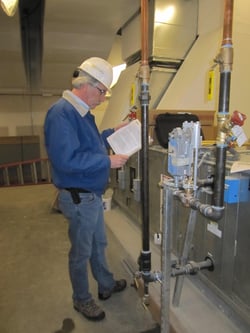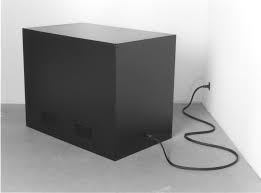Commissioning agents do a large amount of review of other people’s work and products. The building commissioning (Cx) process is a quality-assurance process for verifying and documenting that the performance of facilities, systems, and assemblies meet defined objective criteria[1]. Therefore, to verify facilities and systems, I need access to a product’s technical documentation. In the commercial building space, almost all documentation is online and readily available via a quick Google search. Notice that I said almost.
When I first started in this industry in 2002, almost no product documentation was online. Want to look up a pneumatic actuator’s service kit? Nope, not on the manufacturer’s website. At most, manufacturers would publish their phone number so you could call and ask someone. People were not using PDFs nearly as much as they are today. I used to get Microsoft Word documents, or rich text files for instruction manuals (if instruction manuals were digitized at all).

This lack of information, at first, was generally not a big deal. This is because most commercial buildings are built with open systems and interoperable components. Wait - did I just use a software term to describe how buildings are built? Sure! Here is what I mean.
Open System Building Construction
Duct work is an open-system. It is constructed independent of any one manufacturer’s ‘system’ of parts. It is interoperable. You can take ducts from manufacturer A, and add them to existing duct from manufacturer B. Any mechanical contractor can come in, look at another mechanical contractor’s work from 10 years ago and freely modify or improve upon the existing system. Hydronic piping is open source for the same reasons. The hardware for both these systems is built to industry standards that no one manufacturer owns. This means that a bolt bought at Ace Hardware works with a nut purchased at Home Depot even if the bolt is made by US Bolt and the nut is made by ABS Fasteners.
The benefit of having open systems for construction are so obvious, we never really consider construction to be a set of open systems. For example, if a contractor submits on a lighting fixture that wasn’t specified by the design team, a commissioning agent (CxA) simply searches the web for that lighting fixture’s technical documentation and can verify that the fixture meets the owner’s project requirements (OPR). Furthermore, the CxA can have a discussion with the electrical engineer about whether this meets their design intent. If the owner and design team both approve this new fixture, it might save the owner a good amount of first cost without affecting the design or the facility. This all can happen because the documentation is available, and even though I am using simple systems as an example, they’re all open and interoperable.
Lock it Down, Protect its Secrets
There is one system however that is critical to any building being built successfully that doesn’t always have available online installation documentation. Building HVAC control systems are still sometimes veiled behind a manufacturer/dealer relationship that can make double checking a dealer’s work impossible. This relationship can effectively make a control system a black box. In any technological system, there should never be a black box (but often times there are). Especially those systems that are expected to last for more than a decade.

Photo by Ken Goldberg
Think of it this way - let’s say you bought 100 computers from Dell and specified that they are to run Windows. Let’s say you paid Dell to deliver, set them up, and install Windows on each machine. How can you double check that Dell’s technicians installed Windows per Microsoft instructions? Simple, right? Just go to Microsoft’s website and read the directions. But what if Microsoft hid those directions from you. You’d never be able to tell if your local technician installed Windows per the instructions.
Furthermore, let’s say that you’ve had issues in the past where Windows was not installed correctly and it cost your business lots of capital you didn’t know you were losing because of improper installation. So, this time you hired your local IT company to double check that Dell installed windows per the instructions. Microsoft makes money for each computer Dell sells. Therefore, Dell represents a sales channel for Microsoft. This relationship is protected by Microsoft only providing the instructions to Dell but not making them available to anyone double checking Dell’s work. Microsoft might say they are doing this because only Dell folks are “factory trained” to install Windows properly. However, if the documentation was available, any other industry professional would have a better chance of catching the accidents made by a factory certified dell technician in a rush before they cost the owner money.
The Fox Guarding the Hen House
I recently did some work where I needed to double check some design decisions submitted by a contractor. When I saw something that seemed out of the ordinary I did what I always try to do: read the manual. A quick web search turned up no manuals. I found that none of the controls documentation for designing systems using this product or even properly installing this product were publicly available. I then decided to call the manufacturer. I was told that in order to obtain that information, I would need to call my local dealer. I explained to the manufacturer that it was my local dealer’s work I was double checking and therefore by calling them I would be creating a potential conflict of interest. The manufacturer seemed to be very reluctant to provide answers as they would be essentially helping me find a mistake in their dealer’s work (if such a flaw existed, and I am glad to report that it didn’t).
This was a very uncomfortable position to be stuck in as a commissioning agent. I was trying to get information to do my job of performing quality assurance, reviewing, and documenting. The information I needed to do that job was guarded by the relationship between the manufacturer and their local dealer in my area. So, you can see this as an example of a closed system (even if the controls product uses BACnet or Lon to communicate, in the context of documentation, their system is closed). Contractually, controls contractors are not required to provide this documentation to commissioning agents. Usually controls contractors supply this documentation to the owner in the O&M manuals however by that time it would be too late for a commissioning agent. Even in that situation, sometimes the controls contractors do not provide the installation manual if it is separate from the maintenance information. Since there is no public access to the product documentation, and no public access to technical support except through the dealer that sold the building owner the system – one cannot double check the contractor’s installation against the manufacturer’s instructions.
Those Who Take Pride Have Nothing to Hide
Of course, not every controls manufacturer restricts access to documentation. There are many that are very open with it, which, in my opinion holds all their dealers and installers accountable and provides a value-add for their products. Engineers can access the information to make smarter decisions about HVAC controls that can result in efficiency gains. If you are a building owner with one of these systems, and you lose your operations and maintenance documents (O&Ms), at least you can still find part of that information online.
One controls manufacturer that puts all their documentation out there, and in my opinion, should be commended for it, is Johnson Controls. They have an online product literature website: http://cgproducts.johnsoncontrols.com where you can access their documentation. So, if you want to check whether or not a contractor was supposed to provide a bonded 24vac power source, or whether they’re supposed to use three conductor, 22 gauge TSP wire instead of two conductor, you can easily do so. You can simply use the same installation instructions the contractor will be using when they open the box to make sure they’re installing the system they resell per the manufacturer’s intent. All controls manufacturers could hold their dealer networks to a higher standard if they followed this example, instead of locking down their documentation.
[1] Paraphrased from ASHRAE’s Guideline 0-2005


